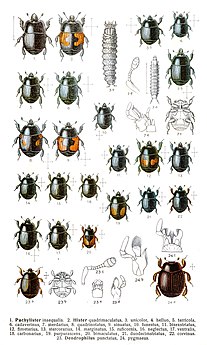
Veld, also spelled veldt, is a type of wide open rural landscape in Southern Africa. Particularly, it is a flat area covered in grass or low scrub, especially in the countries of South Africa, Lesotho, Swaziland, Zimbabwe and Botswana. A certain sub-tropical woodland ecoregion of Southern Africa has been officially defined as the Bushveld by the World Wide Fund for Nature. Trees are found only in a few places—frost, fire and grazing animals allow grass to grow but prevent the growth of trees.

Pemphigus is a rare group of blistering autoimmune diseases that affect the skin and mucous membranes. The name is derived from the Greek root "pemphix," meaning "pustule."

Oecobiidae, also called disc web spiders, is a family of araneomorph spiders, including about 100 described species. They are small to moderate sized spiders (about 2 to 20 millimetres long combined head and body length, depending on the species. Larger ones tend to be desert-dwelling. The legs are unusually evenly placed around the prosoma; most other spiders have some legs directed clearly forward and the rest clearly backward, or all forward. The first two pairs of legs of many Oecobiids point forward then curve backwards; somehow in a running spider this gives a curiously scurrying, wheel-like impression that is characteristic of many Oecobiidae, and is helpful as a rough-and-ready aid to identification in the field. Characteristic of the family is the anal gland; it bears a tuft of long hairs. Typical colour patterns range from dark-patterned cream in some smaller species, to a small number of symmetrically-placed, conspicuous round light spots on a background that may be anything from a dull orange colour to black. The carapace is rounded and bears a compact group of six to eight eyes medially situated near the front of its dorsal surface.

Udea ferrugalis, the rusty dot pearl, is a species of moth of the family Crambidae. The species was first described by Jacob Hübner in 1796.
Pemphigus foliaceus is an autoimmune blistering disease of the skin. Pemphigus foliaceus causes a characteristic inflammatory attack at the subcorneal layer of epidermis, which results in skin lesions that are scaly or crusted erosions with an erythematous (red) base. Mucosal involvement is absent even with widespread disease.
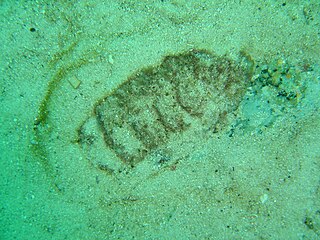
The giant chiton, Dinoplax gigas, is a species of chiton in the family Chaetopleuridae. It is a marine mollusc.

Azanus mirza, the pale babul blue or mirza blue, is a butterfly of the family Lycaenidae. It is found in the Afrotropic ecozone.

Rhyssa persuasoria, the giant ichneumon, is a species belonging to the family Ichneumonidae subfamily Rhyssinae.

Precis pelarga, the fashion commodore, is a species of butterfly in the family Nymphalidae.
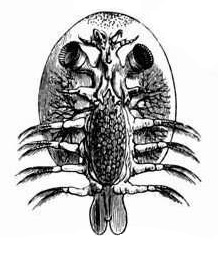
Argulus foliaceus(or Monoculus foliaceus Linnaeus, 1758 name) is a species of crustaceans in the family Argulidae, the fish lice. It is sometimes called the common fish louse. It is "the most common and widespread native argulid in the Palaearctic" and "one of the most widespread crustacean ectoparasites of freshwater fish in the world", considering its distribution and range of hosts. It can cause the severe disease state argulosis in a wide variety of fish species. It is responsible for epizootic outbreaks that have led to the collapse of aquaculture operations. Fish lice are not related to lice, which are insects.

Pactolinus gigas is a species of the Histeridae family of Beetles.

Margarinotus brunneus is a species of beetles belonging to the family Histeridae.
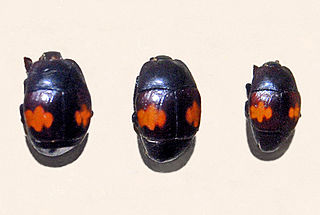
Saprinus ornatus is a species of clown beetles belonging to the family Histeridae.
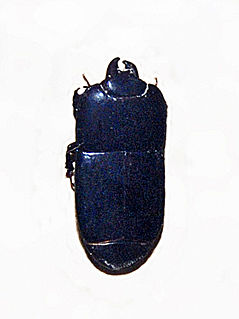
Platylister is a genus of clown beetles belonging to the family Histeridae.

Saprinus splendens is a species of clown beetles belonging to the family Histeridae.

Plaesius javanus, the Jepson's Beetle, is a species of clown beetles belonging to the family Histeridae.
Hololepta aequalis is a species of beetle belonging to the Histeridae family. It is found in North American countries such as Canada and the United States where it lives on an elevation of 525–1,370 metres (1,722–4,495 ft) and feeds on dead poplars. Besides poplars, it also feeds on pines, willows, and tulips. Its body is flat and is 8–11.5 millimetres (0.31–0.45 in) long. Its annuli is V-shaped while its palpi is horizontally projecting in front of the head. The species' antennal lobe is under anterior angles of its prothorax while its labrum is free.
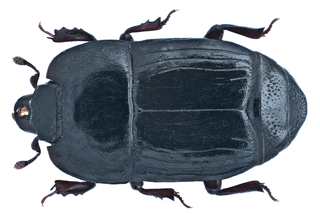
Platysomatini is a tribe of clown beetles in the family Histeridae. There are at least 30 genera and 380 described species in Platysomatini.
Margarinotus obscurus is a species of clown beetle in the family Histeridae. It is found in Africa, Europe & Northern Asia, North America, and Southern Asia.

